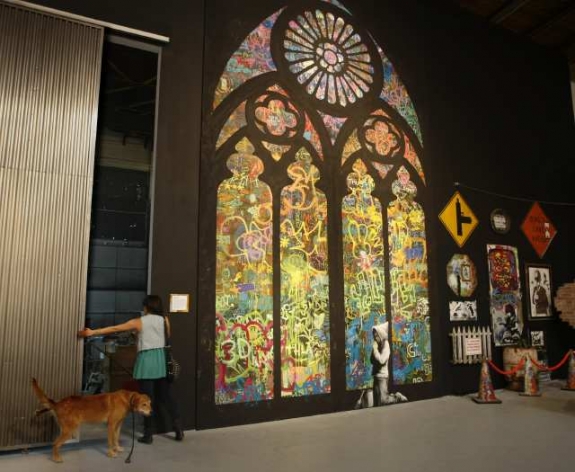It’s generally not a good idea to censor a mural you commissioned, especially when that mural is part of a show about uncommissioned street art.
When Museum of Contemporary Art director and curator Jeffrey Deitch whitewashed a mural by Italian artist Blu in December, the episode perfectly illustrated how graffiti’s unruly, in-your-face attitude, even when sanitized under the banner of “street art,” might not be a good fit for a museum retrospective. The very idea of the exhibition “Art in the Streets” at the Geffen Contemporary asks whether this erstwhile outlaw culture can or should be folded into the grand narrative of art history.
Despite its first, faltering steps, the exhibition answers this question with a resounding “Yes.” Viewers will encounter a bombastic, near-overwhelming cavalcade of eye candy: colorful swirling murals, immersive installations, walls papered with candid and provocative photos, and a custom-designed skate ramp. Immodestly anticipating the response, there’s even a big “WOW” painted on the inside of the building’s roll down doors. But the exhibition’s strong suit is not its impressive array of large-scale work but rather its art historical treatment of an outsider form, complete with a timeline, “period” rooms, and plenty of video and photographic documentation.
Although bright colors, lights and sounds beckon from the galleries on the main floor, it’s worth spending some time with the terse but informative timeline upstairs. It moves briskly from the movement’s beginnings in tagging in New York and Philadelphia in the 1960s, through cholo graffiti in L.A. in ’70s, and the form’s emergence on the New York gallery scene in the ’80s.
It also charts graffiti’s overlap with punk and skateboarding cultures and the emergence of the “Wild Style” that famously blanketed New York subway cars in the ’70s and ’80s. The timeline stops abruptly in 1989, when the New York Metropolitan Transit Authority began its anti-graffiti campaign, but picks up again on the other side of the galleries to chart the movement’s increasing popularity: the founding of Juxtapoz magazine, Shepard Fairey’s Obama “Hope” poster, and last year’s Academy Award-nominated documentary “Exit Through the Gift Shop.”
Because of its outlaw status (despite its long-running influence in art and fashion), street art has not been fully welcomed into the annals of art history. At the press preview, Deitch, his co-curators Roger Gastman and Aaron Rose, and artist Fab 5 Freddy compared street art’s effect to that of Cubism, Constructivism, Dada, Surrealism and Pop Art. That might be a stretch, but this hyping of the exhibition is completely in step with graffiti’s ethos of self-presentation. Spawned with tagging — scrawling one’s name on every available surface — graffiti began as a simple act of self-assertion. In fact, perhaps the first piece of graffiti was created by World War II shipyard inspector James J. Kilroy, who inscribed every piece of equipment with a long-nosed cartoon face and the words “Kilroy was here.”
This character is revitalized in Lance Mountain’s and Geoff McFetridge’s custom skate ramp, basically a collection of inclines and blocks decorated with large, Kilroy-esque faces. Nike, a co-sponsor of the exhibition, will send members of its SB skate team to skate the ramp twice a week, filling the galleries with a soundtrack of scraping and crashing. It’s not the first time skaters have been welcomed into a museum — co-curator Rose built a skate bowl in the 2004 exhibition “Beautiful Losers” at the Yerba Buena Center for the Arts in San Francisco — but in the context of this show, their performance underscores the importance of the body and self-fashioning in street art.



